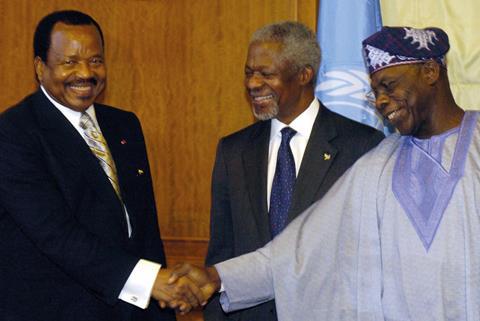Blocking the road to war in border crises are the International Court of Justice, arbitration, mediation – and the lawyers engaged in all three. Marialuisa Taddia reports
The low down
Six nation states claim the Spratly Islands in the South China Sea – a natural land area comprising just 490 acres. Such border and territory disputes are on the rise, reflecting competition for national resources, contested histories and the rise of nationalism. Shrill political rhetoric attends contested territory. But the surprise is how seldom countries reach for their military hardware – instead using the legal remedies available through the International Court of Justice, mediations and ad hoc arbitrations.
Such disputes can run for decades, but most determinations are respected. When the alternative is war, that is something to celebrate.
From the Irish and the South China seas, to the Gaza Strip and Ukraine, there are hundreds of unresolved border crises around the globe. Many date back centuries. Climate change, dwindling natural resources and even the space race are creating new frontiers of tension and challenges for peaceful resolution.
‘Border’ is loosely defined to explain the nature of conflict in these areas. Technically there is a difference between ‘boundary’ and ‘territorial’ disputes. The first are about disagreements between independent states over sea or land border lines, while the second involve larger areas of land or water. But Martin Pratt, director of Canada-based Bordermap Consulting, does not think there is a clear distinction between boundary and territorial disputes because ‘territorial sovereignty and boundaries are inextricably linked’.
He says: ‘If there is disagreement over where a boundary is located, there is by definition disputed territory between the two boundary claims. And if there is a broader dispute over title to territory, the boundaries of that territory will also need to be clarified as part of the dispute settlement, even if the precise location of those boundaries is not the focus of the dispute at present.’
Pratt argues a more useful distinction might be between territorial disputes and ‘delimitation’ disputes – meaning ‘between fundamental disagreements concerning sovereignty over a significant area of territory – for example Kashmir, Palestine, Western Sahara, Crimea, the Falkland/Malvinas islands – and situations in which neighbouring states agree that a boundary exists or, in the case of maritime boundaries, needs to be delimited, but disagree over precisely where that boundary is located’.
But, he stresses: ‘The political context is almost always as important, if not more so, than the legal, historical and geographical context, so one should always be careful about generalisations when it comes to territory, sovereignty and boundaries.’
‘In practice, both boundary and territorial disputes necessarily involve, at their core, a dispute concerning sovereignty over land and territory,’ affirms Dr Constantinos Yiallourides, a research fellow in law of the sea at the British Institute of International and Comparative Law.
Currently, there are about 80 inter-state land boundary disputes involving more than 100 countries, while less than half of the world’s maritime boundaries have been settled, according to Yiallourides, who is also a lecturer in international law at Macquarie University School of Law in Sydney.
These, he points out, include disagreements over: the delimitation or demarcation of international land borders (for example, between China and India in the Doklam/Donglang area); the ownership of island territories (the Falklands/Malvinas between the UK and Argentina); and hydrocarbons (such as Tanzania and Congo in Lake Tanganyika or Iraq’s conflict with Kuwait). Other cases involve ethnic or religious divisions tied to specific territories (such as Jerusalem, Kashmir and Cyprus).
‘One key driver of modern international border disputes is states’ efforts to maximise access to increasingly scarce natural resources, especially offshore petroleum fields,’ observes Freshfields Bruckhaus Deringer partner William Thomas QC. He adds that these are ‘frequently situated in contested waters, inevitably leading to maritime disputes’.

Whatever the reason, these inter-state disagreements ‘ebb and flow until they suddenly become explosive and occasionally lead to armed conflicts’, says Yiallourides. Wars are ‘easy to trigger but their adverse consequences remain for decades, and the peaceful status quo may never be restored. Using peaceful legal [means] rather than armed force is increasingly more efficient’.
But much depends on context. ‘In general,’ Pratt says, ‘the smaller and less inhabited the area at stake, the greater the likelihood of a peaceful resolution. The more “existential” the dispute [in terms of national identity, security, economic prosperity] the harder it is likely to be to resolve.’
There are exceptions. For instance, the Guatemala v Belize case pending in the UN International Court of Justice (ICJ) ‘is undoubtedly an existential dispute from the Belizean perspective, but both sides appear committed to resolving their outstanding territorial issues through a judicial process and accepting the outcome’, Pratt observes.
So what mechanisms for peaceful resolution exist? Naomi Briercliffe, counsel and arbitration lawyer at Allen & Overy in London, says the most common are set out in Article 33(1) of the UN Charter: negotiation, enquiry, mediation, conciliation, arbitration, judicial settlement, resort to regional agencies or arrangements.
‘In many cases, you’ll see a combination of these methods being used, either in succession or in parallel,’ she says. ‘For example, the Ethiopia-Eritrea border dispute, which started in 1998 and concluded in 2018, involved several rounds of mediation, negotiation, facilitated by the good offices of various other states and the UN, and arbitration before the Eritrea-Ethiopia Boundary Commission, seated in The Hague.’
Although the means of peaceful settlement are not set out in order of priority, ‘negotiation is used more often in practice than all the other methods put together’, notes Yiallourides. This is because the states in conflict with each other retain control over the dispute.
International court of justice
The International Court of Justice (ICJ), established by the UN Charter in 1945, began work a year later in The Hague.
The main judicial arm of the UN comprises 15 judges and has two functions: to settle legal disputes submitted to it by states; and to give advisory opinions on legal questions referred by UN organs and agencies such as the UN General Assembly or Security Council.
In making its decisions, the ICJ looks at international treaties and conventions in force, customary international law, the general principles of law recognised by countries, judicial decisions, and the work of legal scholars. Its judgments, which are final, are binding on the states in question.
Of the 15 cases pending before the ICJ, five are on the delimitation of maritime or land boundaries and associated problems, according to the court’s registrar, Belgian jurist Philippe Gautier. They comprise Nicaragua v Colombia (two separate proceedings); Gabon v Equatorial Guinea; Guatemala v Belize; and Guyana v Venezuela.

Gautier told UN News in November that these disputes are ‘very sensitive. For 10 square kilometres, countries may go to extreme solutions sometimes. It is always better to settle that peacefully’.
Although not the only forum for resolving boundary or territorial disputes, ‘the ICJ remains the dominant forum in terms of number of cases’, says Paris-based Dr Georgios Petrochilos QC, partner at law firm Three Crowns.
‘In particular, it seems that the ICJ plenary formation has established itself as a preferable forum compared to the court’s chambers or ad hoc tribunals drawn from ICJ judges, solutions which had appeared to be gaining momentum in the 1970s and 1980s for boundary cases,’ adds Petrochilos.
Greg Falkof is a partner in the international arbitration group at Eversheds Sutherland and has worked on a number of international border disputes. ‘One of the downsides of pursuing bilateral or multilateral negotiations is that these may be protracted and last for years, even decades, and the issues may even be left unresolved,’ he says. Although ‘sometimes that is not necessarily problematic, for example if the dispute between the parties does not flare up. It will also not always be necessary to delimit all boundaries with absolute precision. An informal or political agreement may suffice’.
But where territorial claims or boundary issues result in hostility between states, there are ‘more formal ways of peacefully bringing an end to their dispute’, according to Falkof. For example, international arbitration or referring the matter to an international judicial body such as the ICJ or the International Tribunal for the Law of the Sea (ITLOS) ‘may be a more appropriate way of achieving final resolution of the dispute’.
Charles Claypoole, a partner and arbitration practitioner at Latham & Watkins in London, says: ‘Most disputed boundaries will be successfully negotiated by the states in question, resulting in a treaty that will delimit the shared territorial or maritime boundary.’
But where there is a failure to do so ‘amicably’ when the states nevertheless recognise a need to resolve the boundary dispute (for example, in order to access oil or gas resources or avoid the risk of conflict), options include arbitration under the aegis of the Permanent Court of Arbitration (PCA) or litigation before ITLOS or the ICJ, he explains. ‘Exceptionally, disputes are submitted to mediation or conciliation,’ says Claypoole, who advises clients on international law in disputes over territorial and maritime boundaries.
Maritime border disputes have their own specific regime under the 1982 UN Convention on the Law of the Sea (UNCLOS). This sets out a number of peaceful means for settlement, notes Andrew Cannon, partner at Herbert Smith Freehills. They may be referred to the ICJ, to an ad hoc tribunal established under Annex VII of UNCLOS, or to ITLOS. As with their land counterparts, maritime border disputes may also be submitted to ad hoc arbitration under a treaty (for example Timor-Leste v Australia) or other special agreement.
According to Cannon, there have been disputes before all of these forums in recent years: Somalia v Kenya and Costa Rica v Nicaragua before the ICJ; Barbados v Republic of Trinidad & Tobago, and Guyana v Suriname under Annex VII of UNCLOS; Bangladesh v Myanmar, and Ghana v Ivory Coast before ITLOS; and the ad hoc tribunal constituted in the dispute between Eritrea and Yemen.
Historically, arbitration has been a popular way of settling boundary and territorial disputes, according to Eversheds Sutherland partner Margrit Trein. For example, in the late 19th century Argentina and Chile referred a dispute over claims on Patagonia to arbitration to de-escalate tension. The arbitration considered the Boundary Treaty of 1881 concluded between the two nations and settled the present-day boundaries between them. The award was issued in the name of King Edward VII. ‘Since then, both Chile and Argentina have invoked arbitration to settle subsequent territorial disputes between them,’ she says.
More recently, an arbitration that attracted significant attention was the South China Sea Arbitration between the Philippines and the People’s Republic of China. This started under UNCLOS, with the PCA acting as the registry in the arbitration. ‘While the five-member arbitral tribunal did not make any pronouncements on any issue of sovereignty over land territory, and would not delimit any maritime boundary between the states, the tribunal considered various other international law issues, among them whether certain features in the South China Sea were rocks or islands,’ says Trein. ‘The significance of the determination being that, unlike rocks, islands generate maritime entitlements, which can be of strategic or economic importance for states.
'Since disputes have the potential of upsetting peaceful relations between states and can result in conflict, the ICJ’s work is highly important'
Greg Falkof, Eversheds Sutherland
‘Some inherent features of arbitration make this mechanism of dispute resolution particularly appealing to states in boundary or territorial disputes.’ Trein points to the fact that the procedure is ‘very flexible, provides for a great deal of party autonomy, and can be easily tailored to the specific circumstances of the case and issues in dispute. The parties can also choose their arbitrators. In addition, arbitrations are usually confidential, unless otherwise agreed by the parties’.
‘Many national groups still view their identity largely in terms of the boundary they control,’ says Pratt. ‘It can be very difficult for governments even to hint at the possibility of compromising over national boundaries.’ In this scenario, recourse to the ICJ can be the preferred option because it brings an ‘imposed compromise’. This, he argues, may be more ‘politically acceptable’, though ‘a defeat in court is still a risky proposition in terms of domestic politics’.
The ICJ is the main judicial arm of the UN and, as Falkof observes: ‘Since boundary and territorial disputes have the potential of upsetting peaceful relations between states and can result in conflict and even war, the court’s work in this area is highly important.’
Boundary and territorial cases form an important, and growing, part of the ICJ’s caseload, observes Paris-based Dr Georgios Petrochilos QC, a partner at Three Crowns. They represented about a third of the ICJ’s contentious disputes (as distinct from its advisory opinions) from 1990 to the present. Over the past decade this share has risen to 40%.
‘One must be careful not to draw too many conclusions about this increase in proportion given that the sample size is still relatively small and boundary disputes have been an important part of the court’s work for some time,’ Petrochilos says. ‘Many of the disputes are between Latin American states, most of which have recognised the ICJ’s jurisdiction in a multilateral dispute-resolution treaty known as the Pact of Bogota. But it is safe to say that the court’s track record and docket create a momentum for states to take more of these disputes to it. The growing body of case law provides greater predictability about potential outcomes, which is an important element in selecting a forum.’
So how effective has the ICJ been? ‘That the court is increasingly busy, including with boundary or territorial disputes, suggests that more and more states consider that the ICJ is successfully performing its judicial role,’ Petrochilos says. ‘One may contrast the present period with the quiet decade of the 1970s and the early 1980s, in the aftermath of decisions that had been widely criticised, notably in the South West Africa, Barcelona Traction and Aegean Sea cases.’
In more recent years, the ICJ has been ‘more confident’ in its approach to resolving ‘high-stakes and heavily contested’ boundary cases such as Peru v Chile, Nicaragua v Colombia, Bolivia v Chile and Somalia v Kenya, according to Dr Ryan Manton, a senior associate at Three Crowns. ‘While it is fair to say that the court’s approach has been bold and not always what observers might have predicted, its judgments have gained acceptance,’ he says.
‘ICJ judgments have played an important role in the resolution of a number of inter-state boundary disputes,’ Briercliffe confirms. Compliance with its rulings ‘is generally good, although in some instances it has taken time and involved the assistance of the UN or regional organisations’. For example, in a 2002 case between Cameroon and Nigeria, the ICJ awarded sovereignty to Cameroon over the Bakassi Peninsula. But implementation was only achieved in 2013, after mediation efforts by then UN Secretary-General, Kofi Annan, and the establishment of a Cameroon-Nigeria Mixed Commission to facilitate agreement on various practical issues, Briercliffe notes.
And there are examples of states rejecting the ICJ’s rulings, such as Kenya’s rejection of the October 2021 judgment on its maritime boundary with Somalia.
‘From a strictly legal perspective, the ICJ has been successful in resolving the international boundary disputes submitted to it,’ says Claypoole. But he adds that some decisions have been ‘controversial and in some cases it may be argued that the dispute has not been resolved politically’.
For example, the decision to award sovereignty of the oil-rich Bakassi Peninsula to Cameroon ‘sparked or at least contributed to the subsequent Bakassi conflict and demands for separation of the southern Cameroon territory’, says Claypoole. ‘It is also unclear what the consequences of the recent Kenya/Somalia ICJ judgment will be. Kenya unsuccessfully objected to the ICJ’s jurisdiction and failed to appear at the oral hearing on the merits. The court issued a decision on the disputed maritime boundary that favoured Somalia and it is unclear how Kenya will act in accordance with this decision.’

So how do practitioners assess the contribution to international law by the ICJ in this area? This has been ‘significant’, according to Manton, who points to the court’s formulation of the ‘three-stage’ methodology for delimiting maritime boundaries. The ICJ has applied this method consistently since the 2009 Black Sea judgment (Romania v Ukraine), including most recently in Somalia v Kenya. Manton says the method, also applied by ITLOS and arbitral tribunals, ‘contains a significant degree of judgement, but it nonetheless provides a framework within which states can advance their position and the court can rule on them’.
‘The [UNCLOS] only provides that a delimitation should result in an equitable solution, without the methodology for achieving this, and previous attempts to agree a treaty that expressly referenced equidistance were largely unsuccessful,’ Claypoole explains. So it fell to the ICJ to develop that method.
‘The jurisprudence of the ICJ has been critical to the development of the law related to the delimitation of the continental shelf and EZZ [exclusive economic zones] in particular,’ he says, commenting on the principle formulated by the court.
The ICJ’s jurisdiction is ‘consensual’, which means that both the defendants and the accused must agree to present the case to the court. As Cannon observes: ‘The reality of public international law is that it is consent-, treaty- and custom-based.’ Nor does the ICJ have direct enforcement powers and some states have questioned the decisions that have been made, he points out. Yet, Cannon emphasises: ‘The ruling of an international court and tribunal [is] a decision of international law and carries with it the legitimacy and power of the treaty or instrument under which it was constituted and entrusted with the dispute.’
Some, including Briercliffe, argue that the absence of a supranational authority that can impose boundaries on states without their consent is ‘a key limitation in the resolution of international boundary disputes’. But she points to other factors such as a lack of political will and resources (economic, human and technical).
For Claypoole, the reason why certain outstanding boundary disputes have not been settled ‘must be linked to political factors and intractable legal positions of certain states. For example, China’s position in respect of its sovereignty over the Spratly and Parcel islands in the South China Sea will mean that the resolution of the maritime boundary disputes in that region will in all likelihood remain unresolved for the foreseeable future’. This is despite the fact that the Philippines managed to submit certain aspects of this dispute to arbitration under UNCLOS in proceedings in which China failed to participate, Claypoole adds.

Land and maritime border disputes can have an adverse impact on international investors. When seeking to explore and exploit natural resources under a licence from a given state, they need to know that this state exercises sovereignty or sovereign rights over the relevant territory or maritime space, and on what basis, Cannon notes: ‘Investors also need to consider the risks of reputational damage that may come from investing in a disputed region.’
UNCLOS, he says, establishes a duty of mutual restraints and cooperation until the dispute is resolved, including making ‘every effort to enter into provisional arrangements of a practical nature’. An example of this is a joint development zone (JDZ), an out-of-court solution that avoids the delay and uncertainty of arbitration or litigation.
As Claypoole explains, ‘the area of overlapping claims is jointly developed by the two states, usually through a mechanism involving a joint commission or joint authority established by the two states. This has competence to exploit the hydrocarbon resources in the joint area, and then share the economic proceeds between the two states in agreed proportions’. A recent example is the JDZ between Sao Tome and Principe and Nigeria in the Gulf of Guinea, established in 2003. Similar arrangements have been reached between Guinea-Bissau and Senegal; Colombia and Jamaica; and Tunisia and Algeria.
'We are likely to see more inter-state disputes in relation to ever-dwindling water resources'
William Thomas QC, Freshfields Bruckhaus Deringer
An historic example of a ‘neutral zone’, established under the Uqair Protocol of 1922, saw Kuwait and Saudi Arabia sharing ‘equal rights’ and access to resources, Yiallourides points out: ‘The solution of a joint area may be second best to an agreed boundary, and an important confidence-building measure which may ultimately lead to the resolution of the dispute.’
Inland ecological parks have been established on disputed glaciers and mountains, and other disputed border regions, he notes. From Argentina and Chile to Peru and Ecuador and the US/Canadian border, there are more than 50 examples. ‘Provisional joint ecological and fisheries management zones, whether regional or bilateral, could play an important role in this regard,’ Yiallourides says. ‘The logic for such regimes is pragmatic and practical: demilitarise the disputed areas; establish confidence-building mechanisms; and promote inter-state environmental cooperation. If there is good faith and political will, there is a way.’
And border disputes are expected to increase. ‘We are likely to see more inter-state disputes in relation to ever-dwindling water resources,’ says Thomas, pointing to the recent example of the Kishenganga arbitration between India and Pakistan, which arose under the 1960 Indus Waters Treaty.
‘The consequences of climate change will create new pressures in borderland areas, some of which may spark new international territorial disputes,’ says Pratt. He points out that work is already under way at the International Law Association and the International Law Commission to consider the implications for sovereignty for island states whose territory may become uninhabitable or even totally submerged as a result of rising sea levels.
Manton points to the Seabed Disputes Chamber of ITLOS, created for deep seabed mining disputes. Last year, Dubai announced that it would establish a ‘space court’ for commercial space-related disputes based at its International Financial Centre.
Despite new pressures and specific innovations to address them, lawyers and other commentators believe the broader and well-established framework of international law for resolving border disputes should stand the test of time – whatever challenges arise. That would be to all our benefit.
Marialuisa Taddia is a freelance journalist
































No comments yet